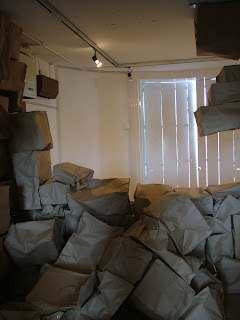A while back my sister Rachel and I were talking about the ‘currency’ of art. Artists invest time, money, energy and thought into creating works in a totally disproportionate amount to the time, money, energy and thought the work seems to generate. My artworks, at this early stage in my career, spend more time in boxes and scattered across the floor and walls of my studio that on view to be seen passing members of public. I’m not disappointed, by any stretch of the imagination, with my progress as an artist over the last two years. Nevertheless, even if I were to secure exhibitions every month, most of my work would still be tucked away in unseen corners of unoccupied spaces.
Yesterday I spent nearly 7 hours on trains and tubes journeying to Worcester and back to collect my artwork from the Worcester City Museum and Gallery. Just days ago the work was hung at eye level, carefully accounted for with a purpose built frame to create depth between the work and the wall and non-heat strip lights wired up to present the work in it’s best light (literally!). In contrast, yesterday the work say rather disappointingly on the floor, propped up against the wall with a dismantled frame next to it, looking out of place as the next show begun to take form around it. This two month show has been my longest exhibition yet but still it inevitably comes to an end and the work gets stowed away again.
To make matters worse, barely having recovered from carrying an old steel window (heavy!) on the train from Worcester to London (Mike met me off the train and got the window the rest of the way to South Ealing, legend)today I had to dismantle my exhibition Of no fixed abode’ from Watford Museum. Timings were never going to be easy. The timetabling at the gallery isn't set up for the large scale installations that I produce (and I'm so glad they didn't let that act as a deterrent to me exhibiting - all in all I found Sophie Ronson and the Museum staff totally and wonderfully accommodating!). My exhibition had to come down at the earliest today and the next show opens on Thursday evening. I assumed that I'd have today to dismantle the exhibition and the new exhibitors would be in on Wed and Thurs setting up...
But I was wrong. By the time I arrived at 1:30 (having finished work for the morning), the next exhibitors (from a local education institution) were already in installing student’s work around my artwork, even having moved some of my work out of the way. I said hello, but barely got a grunt in return. Perhaps they were unhappy with the inconvenience of working around an artist. Whatever it was, I wasn’t hugely comfortable with the situation.
I feel like I’m usually a fairly gracious person but the new exhibitors didn’t acknowledge my work as anything more than an inconvenience – to my mind, the ultimate disrespect. When one of them asked to start taking my wax bricks off the walls at one point I essentially said no, that it was too fragile and I would do it myself. Kelly (the events officer for Watford Council) and Lindsay (museum staff) were fabulous, however. Kelly I hadn’t met before but I felt instantly like she had an understanding of my objects as artworks and so was comfortable with her helping to dismantle the work which she did with due care and attention to detail. It would have been much sadder for me pulling apart the installation if I hadn’t been so guarded and therefore distracted by the new exhibitors.
In the end I was quite happy to get out of there as fast as possible – as my work came down and theirs went up, the space I’d grown so familiar with over the last month was quickly transformed into an unrecognizable space… and at that point I couldn’t get my work out of there fast enough.
Huge huge thanks go to Sophie Ronson and the Museum staff, however, for all their help, patience, understanding and respect for my work. The process of installing the exhibition, all the exhausting, was positive thanks to their willingness to 'take risks' and accomodate my ideas. I would happily work with them again.
All that was left:



















